Chemoprevention of colon cancer: systematic review of aberrant crypt foci and tumor data in rats.
Clik here to go back to main page & database
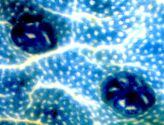
ACF : Aberrant Crypt Focus
Aberrant crypt foci (ACF) are putative precursors of colon cancer. ACF were first detected in rodents in 1987 by Ranjana Bird, few weeks after carcinogen injection. The crypts in ACF are easy to score on whole mount colon. See more ACF pictures & photos on companion website. How can one detect an ACF?
- ACF are two to three times larger than normal crypts,
- ACF are microscopically elevated,
- ACF have a slit-like opening,
- ACF have a thick epithelial lining that stains darker than normal crypts, with a large pericryptal zone.
It was demonstrated that:
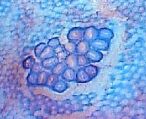 - (1) ACF were induced by all colon carcinogens in a dose- and species-dependant manner;
- (1) ACF were induced by all colon carcinogens in a dose- and species-dependant manner;
- (2) ACF number and growth were modified by the modulators of colon carcinogenesis, and they predicted the tumor outcome in several rodent studies;
- (3) ACF correlate with colon cancer risk, and adenoma size and number in humans;
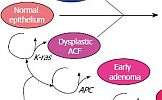 - (4) the morphological and genotypic features of ACF in human colons were similar to those in animal colons, and many alterations are similar in ACF and in tumors;
- (4) the morphological and genotypic features of ACF in human colons were similar to those in animal colons, and many alterations are similar in ACF and in tumors;
- (5) some ACF show dysplasia, and carcinoma were observed in rodents and humans' ACF.
We thus propose on the right below, a colon carcinogenesis model (adapted from Bruce & Corpet, 1996. Mutations from Kinzler & Vogelstein, 1996). You may prefer an alternative, less imaged but more recent, view of ACF-to-Cancer road map (Worthley et al., 2007).
Enlarge color figure above - Enlarge B&W figure below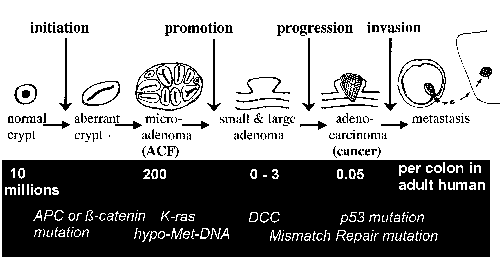
The use of the ACF system to study modulators of carcinogenesis has accelerated for the last 10 years, for it provides a simple and economical tool for preliminary screening of potential chemopreventive agents, and it allows a quantitative assessment of the mechanisms of colon carcinogenesis. The role of ACF as preneoplastic lesions was however recently challenged, and Mucin Depleted Foci. could be better endpoints (or MDF, BCAC, flat ACF, ACFmin) as discussed on a companion website: MDF & BCAC. I am however interested in ACF because they afford a relatively quick and simple way to screen for compounds in the diet that might either cause or inhibit colon cancer.
Why are ACF so much used?
Would it be better to use the cancer endpoint?
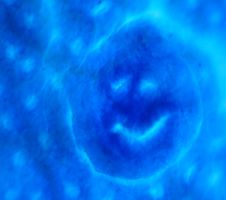
Before 1990, the gold standard endpoint for chemoprevention in rodents was the incidence of macroscopic tumors and colon cancers: colon adenomas and adenocarcinomas induced by a chemical carcinogen.
These endpoints are clearly related to cancer, but have three major drawbacks:
- (1) a tumor requires a long time to develop (usually 5-8 months),
- (2) each tumor must be confirmed by histology, which is long and costly, and
- (3) each animal brings little information to the study (each rat has either no tumor or a tumor), thus large groups of rats are needed for statistical analysis (typically 30 rats or more per group).
This is why leader scientists use ACF as a preliminary endpoint in colon cancer chemoprevention studies. Like them, we wanted to find potent agents, diet, or treatment to prevent intestinal tumors in preclinical studies. We thus made a systematic review of chemoprevention studies on ACF, including the findings from the people cited above. This review is given in detail in the attached database.
See wonderful drawings of colon mucosa and crypts.
Clik here to go back to main page
Corpet DE & Taché S, 2002, Nutrition & Cancer - & - DE Corpet & F Pierre, 2003, Cancer Epidemiol. Biomarkers Prevention
http://www.inra.fr/reseau-nacre/sci-memb/corpet/indexan.html & Mirror site


 - (1) ACF were induced by all colon carcinogens in a dose- and species-dependant manner;
- (1) ACF were induced by all colon carcinogens in a dose- and species-dependant manner;  - (4) the morphological and genotypic features of ACF in human colons were similar to those in animal colons, and many alterations are similar in ACF and in tumors;
- (4) the morphological and genotypic features of ACF in human colons were similar to those in animal colons, and many alterations are similar in ACF and in tumors; 
